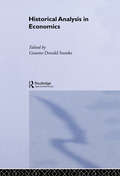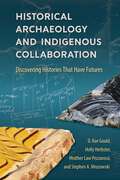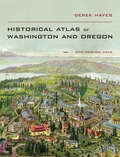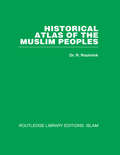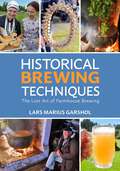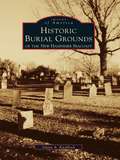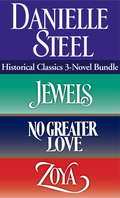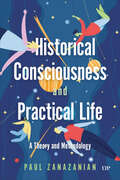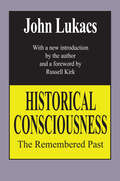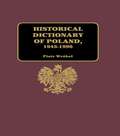- Table View
- List View
Historical Agency and the 'Great Man' in Classical Greece
by Sarah Brown FerrarioThe 'great man' of later Greek historical thought is the long product of traceable changes in ancient ideas about the meaning and impact of an individual life. At least as early as the birth of the Athenian democracy, questions about the ownership of the motion of history were being publicly posed and publicly challenged. The responses to these questions, however, gradually shifted over time, in reaction to historical and political developments during the fifth and fourth centuries BC. These ideological changes are illuminated by portrayals of the roles played by individuals and groups in significant historical events, as depicted in historiography, funerary monuments, and inscriptions. The emergence in these media of the individual as an indispensable agent of history provides an additional explanation for the reception of Alexander 'the Great': the Greek world had long since been prepared to understand him as it did.
Historical Analysis in Economics
by Graeme Donald SnooksNeo-classical economics is frequently criticised for paying inadequate attention to historical processes. However, it has proved easier to make broad claims that `history matters' than to theorise with any depth about the appropriate role for history in economic analysis. Historical Analysis in Economics considers what history can contribute to the science of economics: how would it matter if `history mattered?'
Historical Animals: The Dogs, Cats, Horses, Snakes, Goats, Rats, Dragons, Bears, Elephants, Rabbits and Other Creatures that Changed the World
by Julia MobergThroughout history, animals have shaped the world as we know it. But rarely have they received the recognition they deserve. Until now.This inside look at history’s most famous animals features wacky verse, cool facts, historical stats, and zany cartoon art. Meet Alexander the Great’s horse Bucephalus, who was his battle companion for nearly 30 years. Learn about Mozart’s starling bird that helped him write music by singing along as he composed. Read about the Ethiopian goats that discovered the coffee bean, Marco Polo seeing dragons in China, and a dog named Boatswain that saved Napoleon’s life. From the cobra that killed Cleopatra to Cairo, the dog that helped hunt down Osama bin Laden, Historical Animals has these stories and more!
Historical Archaeology and Indigenous Collaboration: Discovering Histories That Have Futures
by Stephen A. Mrozowski D. Rae Gould Holly Herbster Heather Law PezzarossiSociety for American Archaeology Scholarly Book AwardCollaborative archaeological projects focused on the Nipmuc people of New England that offer a model for research incorporating Indigenous knowledge and scholarship Highlighting the strong relationship between New England’s Nipmuc people and their land from the pre-contact period to the present day, this book helps demonstrate that the history of Native Americans did not end with the arrival of Europeans. This is the rich result of a twenty-year collaboration between indigenous and nonindigenous authors, who use their own example to argue that Native peoples need to be integral to any research project focused on indigenous history and culture. The stories traced in this book center around three Nipmuc archaeological sites in Massachusetts—the seventeenth century town of Magunkaquog, the Sarah Boston Farmstead in Hassanamesit Woods, and the Cisco Homestead on the Hassanamisco Reservation. The authors bring together indigenous oral histories, historical documents, and archaeological evidence to show how the Nipmuc people outlasted armed conflict and Christianization efforts instigated by European colonists. Exploring key issues of continuity, authenticity, and identity, Historical Archaeology and Indigenous Collaboration provides a model for research projects that seek to incorporate indigenous knowledge and scholarship.
Historical Atlas of Northeast Asia, 1590-2010: Korea, Manchuria, Mongolia, Eastern Siberia
by Robert Cribb Narangoa LiFour hundred years ago, indigenous peoples occupied the vast region that today encompasses Korea, Manchuria, the Mongolian Plateau, and Eastern Siberia. Over time, these populations struggled to maintain autonomy as Russia, China, and Japan sought hegemony over the region. Especially from the turn of the twentieth century onward, indigenous peoples pursued self-determination in a number of ways, and new states, many of them now largely forgotten, rose and fell as great power imperialism, indigenous nationalism, and modern ideologies competed for dominance.This atlas tracks the political configuration of Northeast Asia in ten-year segments from 1590 to 1890, in five-year segments from 1890 to 1960, and in ten-year segments from 1960 to 2010, delineating the distinct history and importance of the region. The text follows the rise and fall of the Qing dynasty in China, founded by the semi-nomadic Manchus; the Russian colonization of Siberia; the growth of Japanese influence; the movements of peoples, armies, and borders; and political, social, and economic developments—reflecting the turbulence of the land that was once the world's "cradle of conflict." Compiled from detailed research in English, Chinese, Japanese, French, Dutch, German, Mongolian, and Russian sources, the Historical Atlas of Northeast Asia incorporates information made public with the fall of the Soviet Union and includes fifty-five specially drawn maps, as well as twenty historical maps contrasting local and outsider perspectives. Four introductory maps survey the region's diverse topography, climate, vegetation, and ethnicity.
Historical Atlas of Washington and Oregon
by Derek HayesThis gorgeous atlas, illustrated throughout with more than 500 colorful images and maps, provides a visually rich and textually engaging history of the states of Oregon and Washington. Derek Hayes brings his enthusiasm and expertise to a full range of topics, beginning with the first inhabitants and tracing the westward expansion, conflict between settlers and Native Americans, and the establishment of the Oregon Trail. We see in vivid images, old maps, and lively text the coming of the railroads and the rapid establishment of the coastal ports, northwest cities and roads, the fur and lumber industries, and the large farms. We also witness the twentieth-century development of the war industries, the establishment of the aviation industry, and the celebratory 1962 Seattle World's Fair. At once a valuable reference and an exhilarating adventure through history, the Historical Atlas of Washington and Oregon presents readers with a fascinating chronicle of how these proud states came into their own and how they each look toward the future.
Historical Atlas of the Muslim Peoples
by R RoolvinkOriginally published in 1957. Within the compact range of fifty-six maps, this atlas depicts clearly and concisely the expansion of Islam outwards from the Arabian Peninsula and outlines the rise and decline of the various Muslim states and dynasties over a territory stretching from Spain to China. Maps have also been devoted to trade products and routes, both in the heartland of Islam and in the basins of the Indian Ocean and the Mediterranean Sea. This volume represents a series of maps which together present a full survey of the history of Islam in time and space.
Historical Atlas of the Third Reich
by Richard OveryFormally inaugurated in Potsdam in 1933, the Third Reich was regarded by Hitler as the greatest in a line of might German empires. His mystical belief that this empire would last a thousand years proved unfounded, but not before a world war which resulted in the loss of at least 70 million lives. This atlas charts the rise and fall of Hitler's Nazi state, from the first mass meeting of the NSDAP in Munich in 1920, through the relentless territorial aggression and anti0Jewish atrocities of World War II, to the execution of war criminals in Nuremburg in 1946.The Historical Atlas of the Third Reich offers penetrating insights into the seemingly inexorable rise of National Socialism and examines the nature of Hitler's power structures both within his party and within Germany as a whole.
Historical Atlas of the United States
by Mark C. CarnesDesigned for all libraries, this large-format, full-color atlas is an authoritative guide to the history of the United States. From the formation of the continent up through current events and information based on the most recent census, this work uses the geography of the United States to portray the history of the land and its people. The 300-plus maps tell the engaging story of America with detailed, clear information; accompanying text highlights key information presented in each map. An indispensable tool for students and educators alike, the Historical Atlas of the United States is destined to become a classic in the field.
Historical Box Set
by James Green Tom WilliamsFive full length novels from best-selling Historical fiction authors in one boxset Another Small Kingdom - James Green America was the land of the free - but could it stay that way? James Green uses fictional characters to illuminate the real events that lead to the birth of the American Intelligence Services and culminated in the extraordinary Louisiana Purchase, which doubled the size of the USA - at the cost of 3 cents an acre. Packed with action and fascinating historical detail, Another Small Kingdom will appeal both to those interested in the history of the USA and to aficionados of intelligent spy thrillers. Boston, 1802, Lawyer Macleod is a man full of hate, a dangerous man. When a newly arrived young lawyer is mad enough to insult him, the consequences spin out of control and Macleod is caught up in a web of danger and intrigue. With England at war with France, some powerful Americans feel that the USA's best chance of remaining independent is to throw in their lot with France- even if it means accepting a French king - for a while. To counter their plot, Macleod is sent toNew Orleans, where he meets Marie, wife of Etienne de Valois, aristocrat and fop, and through her learns a terrible secret. Together, unable to trust anyone, they race to uncover the traitors at the heart of the American Government. Just One Damned Thing After Another - Jodi Taylor "History is just one damned thing after another" - Arnold Toynbee A madcap new slant on history that seems to be everyone's cup of tea... Behind the seemingly innocuous façade of St Mary's, a different kind of historical research is taking place. They don't do 'time-travel' - they 'investigate major historical events in contemporary time'. Maintaining the appearance of harmless eccentrics is not always within their power - especially given their propensity for causing loud explosions when things get too quiet. Meet the disaster-magnets of St Mary's Institute of Historical Research as they ricochet around History. Their aim is to observe and document - to try and find the answers to many of History's unanswered questions...and not to die in the process. But one wrong move and History will fight back - to the death. And, as they soon discover - it's not just History they're fighting. Follow the catastrophe curve from eleventh-century London to World War I, and from the Cretaceous Period to the destruction of the Great Library at Alexandria. For wherever Historians go, chaos is sure to follow in their wake... Burke in the Land of Silver - Tom Williams The first instalment of Tom Williams' series His Majesty's Confidential Agent. A tale of spies and skulduggery in the Napoleonic Wars as Britain invades Argentina. James Burke joins the army determined to work his way up through the ranks and become a gentleman. He never set out to be a spy. But with Napoleon rampaging through Europe, the Duke of York needs agents and Burke is plucked from the infantry and sent on a mission to the Spanish colonial backwater of Argentina. His mission is to give the country's freedom fighters aid so that they may break free from Spanish rule at an opportune moment for Britain. Yet when Burke arrives, he finds himself falling in love, both with the Land of Silver, and Ana O'Gorman, lover of a rebel leader determined to bring about Burke's downfall... Crosscurrents - Jane Jackson Santo Innis is developing a revolutionary new engine to counter the lethal effects of high-pressure steam. His backer is Richard Vaughan, heir to Frederick Tregarron, owner of Gillyvean estate. Following the tragic deaths of his wife and baby son, Richard immersed himself in work. But his world is turned upside down by the unexpected arrival at Gillyvean of Melanie Tregarron, a talented artist and Frederick's illegitimate youngest daughter. Desperate to prove the viability of his invention, Santo persuades Richard to let him fit one at Gillyvean's brewhouse. But when Bronnen Jewell - worried about her mother's suffering at her father's hands - arrives to brew the harvest beer she's horrified, fearing loss of the i...
Historical Brewing Techniques: The Lost Art of Farmhouse Brewing
by Lars Marius GarsholAncient brewing traditions and techniques have been passed generation to generation on farms throughout remote areas of northern Europe. With these traditions facing near extinction, author Lars Marius Garshol set out to explore and document the lost art of brewing using traditional local methods. Equal parts history, cultural anthropology, social science, and travelogue, this book describes brewing and fermentation techniques that are vastly different from modern craft brewing and preserves them for posterity and exploration. Learn about uncovering an unusual strain of yeast, called kveik, which can ferment a batch to completion in just 36 hours. Discover how to make keptinis by baking the mash in the oven. Explore using juniper boughs for various stages of the brewing process. Test your own hand by brewing recipes gleaned from years of travel and research in the farmlands of northern Europe. Meet the brewers and delve into the ingredients that have kept these traditional methods alive. Discover the regional and stylistic differences between farmhouse brewers today and throughout history.
Historical Burial Grounds of the New Hampshire Seacoast (Images of America)
by Glenn A. KnoblockHistoric Burial Grounds of the New Hampshire Seacoast, a photographic study of Colonial Era-burial grounds, uncovers the fascinating history of the area from the 1680s to 1810. These early cemeteries are a direct link to our past, and yet very little has been done to preserve their history through photographs. By understanding how, why, and by whom these gravestones were made, the symbolism they portray can be understood, and we will gain a clearer understanding of the ways in which our ancestors lived and died. The burial grounds and the gravestones within them have often been called "open air museums." They contain some of the oldest works of art found in the area; some gravestones are more than 300 years old. Through the author's collection of photographs, one can see the entire range of images present in the area's old burial grounds, including grinning skulls and crossbones, heavenly cherubs, and epitaphs that tell magnificent tales. This collection is a must for anyone interested in local history, genealogy, or colonial-era art.
Historical Capitalism
by Immanuel WallersteinA succinct introduction to the history of capitalism by the renowned political theorist. In this short, highly readable book, the master of world-systems theory provides a succinct anatomy of capitalism over the past five hundred years. Considering the way capitalism has changed and evolved over the centuries, and what has remained constant, he outlines its chief characteristics. In particular, he looks at the emergence and development of a world market, and of labor; in doing so, he argues that capitalism has brought about immiseration in the Global South. As long as they remain within a framework of world capitalism, Wallerstein concludes, the economic and social problems of developing countries will remain unresolved.Historical Capitalism, published here with its companion essay Capitalist Civilization, is a concise, compelling beginners' guide to one of the most challenging and influential assessments of capitalism as a world-historic mode of production.
Historical Classics 3-Novel Bundle: Jewels, No Greater Love, And Zoya
by Danielle SteelIn book after beloved book, New York Times bestselling author Danielle Steel consistently writes captivating stories notable for their unforgettable characters, page-turning plots, and richly imagined settings. Steel’s sweeping, emotionally resonant historical novels in particular hold a special place in readers’ hearts. Now here’s a convenient eBook bundle that features three classic historical novels—Jewels, No Greater Love, and Zoya—stellar fiction from the incomparable Danielle Steel. Includes an excerpt from Danielle Steel’s latest historical novel, Legacy, a compelling, centuries-spanning novel that brilliantly interweaves the lives of two women.
Historical Consciousness and Practical Life: A Theory and Methodology
by Paul ZanazanianHistorical Consciousness and Practical Life introduces a novel approach to examining how people construct and employ historical knowledge in their daily lives. In viewing history as an embodied cultural practice that constitutes the background to our meaning-making, the book demonstrates how researchers and others can investigate the ways in which people make sense of time’s flow in their now-moment engagements with the world and use that information to position themselves regarding key social problems with historical roots. The book provides a glimpse at how humans enter historically embedded thinking problems, seeking to resolve them. Paul Zanazanian draws on a study of the community leaders of English-speaking Quebec to illustrate the practical life methodology’s workings. In looking at their different uses of history for strengthening their group’s vitality in the province, he identifies five key stances these leaders employ for positioning their sense of purpose and responsibility for securing English-speaking Quebec’s future. Ultimately, Historical Consciousness and Practical Life argues that community leaders who complicate and problematize their uses of history are the best positioned to make positive transformations for their group.
Historical Consciousness: The Remembered Past
by John LukacsOne of the most important developments of Western civilization has been the growth of historical consciousness. Consciously or not, history has become a form of thought applied to every facet of human experience; every field of human action can be studied, described, or understood through its history. In this extraordinary analysis of the meaning of the remembered past, John Lukacs discusses the evolution of historical consciousness since its first emergence about three centuries ago.
Historical Controversies and Historians
by William LamontFor students new to the subject of history there are many books on the "theory" of writing history but fewer on how history is actually "practised". This work by a team of historians from the University of Sussex fills this gap. The first half of the book examines a number of notable controversies that have been, and still are, the subject of historical debate - for example, race in South Africa, the legacy of the French Resistance, the origins of the Welfare State. These illustrate the issues involved in "doing" history. The second half of the book focuses upon the historians themselves - such as Tawney, Carr, Buckhardt, Weber, Thompson - and demonstrates how the historian puts his/her own spin on historical interpretation. Together the study of controversies and historians shows with clarity the practical issues of historical method. "Historical Controversies and Historians" should be a useful primer for any student embarking on a course in history.
Historical Criminology (Key Ideas in Criminology)
by David Churchill Henry Yeomans Iain ChanningThis book sets an agenda for the development of historical approaches to criminology. It defines ‘historical criminology’, explores its characteristic strengths and limitations, and considers its potential to enhance, revise and fundamentally challenge dominant modes of thinking about crime and social responses to crime. It considers the following questions: What is historical criminology? What does thinking historically about crime and justice entail? How is historical criminology currently practised? What are the advantages and disadvantages of different approaches to historical criminology? How can historical criminology reshape understandings of crime and social responses to crime? How does thinking historically bear upon major theoretical, conceptual and methodological questions in criminological research? What does thinking historically have to offer criminological scholarship more broadly, and the uses of criminology in the public realm? In this book, Churchill, Yeomans and Channing situate ‘historical thinking’ at the heart of historical criminology, reveal the value of historical research to criminology and argue that criminologists across the field have much to gain from engaging in historical thinking in a more regular and sustained way. This book is essential reading for all criminologists, as well as students taking courses on theories, concepts and methods in criminology.
Historical Development of English Learning Motivation Research: Cases of Korea and Its Neighboring Countries in East Asia (English Language Education #21)
by Tae-Young KimThis book clarifies the fundamental difference between North America-based instrumental motivation and Korea (and East Asia)-specific competitive motivation by which the EFL learners’ excessive competition to be admitted to famous universities and to be hired at a large-scale conglomerate is the main source of L2 motivation. It enables readers to understand that EFL-learning motivation reflects unique sociohistorical contexts grounded in a specific region or country. This book in turn necessitates the need to develop EFL motivation theory and research tradition which are firmly based on East Asian values and culture.
Historical Dictionary of Eritrea (Historical Dictionaries of Africa)
by Dan ConnellIn 1991, Eritrea, a country in northeast Africa, won a 30-year war for independence from Ethiopia, and in 1993 it was recognized as Africa's newest nation after more than a century of conquest and occupation by a succession of external powers that included the Ottomans, Egypt, Italy, Great Britain, and Ethiopia. Each left its mark while fostering a deep distrust of outsiders and a fierce commitment to Eritrea's separate political identity. Eritrea and Ethiopia slipped into a chronic state of no-peace-no-war that kept the entire Horn of Africa off balance for nearly two decades. The standoff ended in 2018 when a newly installed Ethiopian prime minister reached out to Eritrea and set in motion a rapid-fire series of talks among the states of the African Horn that broke down long-standing barriers and raised hopes for a new era of regional peace and cooperation. This third edition of Historical Dictionary of Eritrea contains a chronology, an introduction, appendixes, an extensive bibliography, and more than 600 cross-referenced entries on important personalities and aspects of the country's politics, economy, foreign relations, religion, and culture. This book is an excellent resource for students, researchers, and anyone wanting to know more about Eritrea. DAN CONNELL is a visiting scholar at Boston University's African Studies Center and a retired senior lecturer in journalism and African politics at Simmons College, Boston. He has also consulted for numerous development agencies and human rights organizations and is the founder and former director of Grassroots International. He is working on a book about the experiences of Eritrean refugees. The DAISY markup is as follows: Letters of the alphabet are at level 1; individual entries are at level 2.
Historical Dictionary of Poland 1945-1996
by Piotr WróbelLocated between the former Soviet Union and eastern Germany, Poland has the potential to become a political and economic bridge between the East and West. It is crucial to European security and stabilization; yet the list of reference books on recent Polish history is very short. This book fills that gap, providing information on Polish political, economic, and cultural history since 1945.
Historical Dictionary of Zionism (Religions, Philosophies, And Movements Ser. #No. 31)
by Chaim I. Waxman Rafael MedoffThe Jewish attachment to Zion is many centuries old. Although the modern Zionist movement was organized only a little more than a century ago, the roots of the Zionist idea reach back almost 4,000 years, to the day that the biblical patriarch Abraham left his home in Ur of the Chaldees to settle in the promised land The Historical Dictionary of Zionism is an excellent source of information on Zionism, its founders and leaders, its various strands and organizations, major events in its struggle, and its present status. By showing the movement's strengths and weaknesses, it also acts as a corrective to overly idealistic comments by its supporters and the wilder claims of its opponents. A much more realistic understanding is offered in the Introduction, which presents and explains the movement; the Chronology, which shows its historic progression; the Dictionary, which includes numerous entries on crucial persons, organizations and events; and the Bibliography, which points the way to further reading.
Historical Dictionary of the 1940s
by James Gilbert Ryan Leonard C SchlupThe only available historical dictionary devoted exclusively to the 1940s, this book offers readers a ready-reference portrait of one of the twentieth century's most tumultuous decades. In nearly 600 concise entries, the volume quickly defines a historical figure, institution, or event, and then points readers to three sources that treat the subject in depth. In selecting topics for inclusion, the editors and authors offer a representative slice of life as contemporaneous Americans saw it - with coverage of people; movements; court cases; and economic, social, cultural, political, military, and technological changes. The book focuses chiefly on the United States, but places American lives and events firmly within a global context.
Historical Dictionary of the British and Irish Civil Wars, 1637-1660 (Historical Dictionaries Of War, Revolution, And Civil Unrest Ser. #No. 14)
by Martyn BennettDuring the 17th century the British Isles were trapped in a 23-year-long state of turmoil through civil war, continued rebellion, and revolutions. King Charles I wanted to instill a new uniform religious policy throughout the British Isles, and this caused a massive uproar over the King's policies toward the diverse people in his kingdom, the English, Irish, Scottish, and Welsh. Through a concise historical chronology and comprehensive overview, users of the Historical Dictionary of the British and Irish Civil Wars will find a very insightful explanation of the people, places, and events that indelibly shaped the United Kingdom's 17th-century history. The cross-listed dictionary entries offer a complete explanation of each important aspect of the Civil Wars and their effect on the kingdom. Also includes maps and a bibliography.
Historical Dictionary of the Reformation and Counter-Reformation (Religions, Philosophies, And Movements Ser. #No. 27)
by Hans J. HillerbrandThe Reformation of the 16th century has always been seen as one of the pivotal events in European history. Lord Acton, the famous 19th-century British historian, compared the importance of Martin Luther's speech at the diet at Worms in 1521 with Napoleon's defeat at the Battle of Waterloo in 1813. Lord Acton's may or may not be an extravagant claim, but it is certainly true that the events of the 16th and 17th centuries, now called the Reformation and Counter-Reformation, changed forever the religious and political history of the West.The Historical Dictionary of the Reformation and Counter-Reformation provides a one-volume, balanced, alternative to the overwhelming amounts of literature on the events of the time and the theological and political debates that spawned those events.

